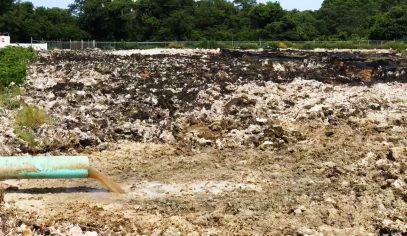Diamonds in The Rough
“The amphibious excavator is saving me $3,000 per day.” Thom S.
Poultry is the second-most widely consumed meat in the world, after pork – a multi-billion dollar industry that provides millions of jobs. In the US alone, the poultry industry provides 1,682,269 jobs, $96 billion in wages, $441.15 billion in economic activity and $34 billion in government revenue. Many poultry slaughtering plants handle more than a million chickens a week, and generate millions of gallons of wastewater in the process. The waste from such facilities includes feathers, dirt, fecal matter, blood, slaughtering wastewater, carcass parts, and animal fat. These processing facilities need large swathes of land to hold discharged waste awaiting further treatment to meet the stringent environmental regulations enforced by the EPA.
If the waste is left untreated, contaminated wastewater and liquefied sludge will gradually seep into the surrounding groundwater, spreading contaminants for miles and polluting local clean water sources. The need for speedy and efficient methods to manage this waste is urgent. Apart from protecting the living environment of people residing near such facilities, it also an opportunity to revitalize the industry and generate employment.


Waste discharge to the temporary holding area
In this particular case study of a poultry plant, the discharged waste could be recycled and blended into a highly effective organic fertilizer beneficial to both the poultry and agricultural industries, a conscientious effect toward environmental sustainability. Crops grown with blended compost result in higher yield and provide lower-cost feed for the poultry industry. Recycling the waste discharged from the poultry industry for the growing of crops would create a sustainable ecosystem between these two industries, reversing the damage done to soil due to decades of intensive agriculture with chemical fertilizers. However, the waste had to be extracted first.


Recovery of discharged waste for processing into organic fertilizer
Smart Hands Make Quick Work
The waste holding areas of the poultry plant spread across acres of land similar to a tailing pond in a mining site. Waste management contractors used long reach excavators to recover material from the perimeter of pond, a slow process that was not able to cope with the vast amount of discharge coming from the poultry processing plant. A long reach excavator is at best, able to reach out to 55ft from the fringe of the pond – material beyond this distance is unreachable. A standard crawler excavator is not able to trek to the center of the pond, where the waste deposit, mixed with waste water, is too soft for the machine to stay afloat. The use of pumps is also impractical due to the high viscosity of the waste and the presence of large debris.
Our solution was to deploy a Cat320E long reach amphibious excavator inside the pond, with the purpose of transferring waste material from the center of the pond to the side, to be subsequently picked up by a regular long reach excavator.
The photographs on the right were taken from the operator’s cabin of the amphibious excavator. The machine effortlessly traversed the entirety of the pond, moving previously inaccessible material. The discharged waste was removed from the pond before it could decompose and leach pollutants into the surrounding environment. Waste management productivity increased, and the cost for the poultry plant was reduced as less machinery and manpower was required.


Photos taken from operator ‘s cabin
“The amphibious excavator allows me to reach material that would otherwise require dewatering pumps. Productivity has increased by 23-24%. We are able to collect 500 tons of material daily.” Thom S.
The main features of the amphibious undercarriage comprises of two large hermetically sealed pontoons fitted with caterpillar track. Movement is accomplished by the ‘multi-synchronous’ hydraulic drive system on each pontoon. The pontoon undercarriage provides the necessary buoyance and extreme low ground pressure, and a higher level of tractive efficiency over wide range of soft terrains. An optional supplementary pontoons and hydraulic spud system can be added to enhance the stability and operability in the event of working in shallow water environment.

Size or Speed? You Can Have Both
EIK’s amphibious excavator is known not just for its high performance, patented ‘multi-synchronous’ drive system, but also its telescopic extendable pontoons that have unequivocally impressed customers. Once experienced, it is a feature that users cannot do without. The built-in hydraulic actuator in the pontoon enables it to be retracted and extended ‘on-the-fly’ from the comfort of the operator’s cabin. With it, a 20 ton class amphibious excavator can reduce its footprint down to a narrow 15’9” (4.8m), allowing it to be transported easily on a single low bed trailer. Without the need for disassembly and assembly when transporting the machine from one job site to another, time and cost is saved.


Patented Drive System
EIK’s patented ‘multi-synchronous direct drive’ system is credited for being the pivotal technology that positions us at the forefront of amphibious excavator products. This paradigm shift in how modern amphibious machines are designed has won over the hearts of numerous customers, for both new and experienced amphibious excavator users.
